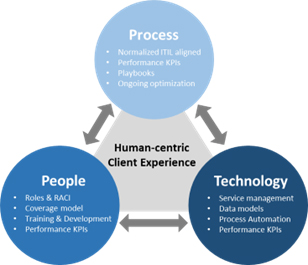Redefining The MSP Human-Centric Client Experience In An Era Of Chatbots
By Sumeet Sabharwal, Netgain

In the era of automation and AI, not a day goes by that you don’t hear headline-grabbing news about machines overtaking humans. Large language AI models like ChatGPT have been at the center of many recent discussions around a rapidly changing world. ChatGPT has caught everyone’s imagination with far-fetched predictions of how it will fundamentally transform humankind.
Certainly, AI and other new technologies are reshaping our landscape. However, from the client’s point of view, the prevalence of chatbots is making it increasingly hard to connect with an actual human. As a result, the consumer comes to dread the very possibility of needing support for any technological device. As the economy tightens and companies turn their attention to reducing costs further, the wave of digital service efficiency at the expense of the personal touch will likely increase. Already, low-cost airlines like Frontier are announcing widely that they would rather not spend the money for someone to pick up the phone.
Most other companies have progressively navigated the issue by adopting a tiered approach – progressively shifting interactions to chat or text instead of the phone – and inserting chatbots up front to handle the initial triage. While this strategy may seem appealing for consumer services when cost efficiencies become paramount, there is an opportunity to rethink the playbook on the B2B side as part of an increasingly widening opportunity for differentiation.
As MSP providers, clients trust us with their most prized asset: their IT infrastructure which is truly their digital lifeline. An MSP’s core business and end users rely on our always-on, always-accessible cloud-based IT solutions to power their core business. When things go smoothly, the MSP’s underlying technology remains an abstract notion to clients. However, when things become rocky, the end users at client companies will become hyper-aware of their digital workspace because it is not serving them effectively.
When IT infrastructure platforms hit a rough patch, the client’s patience levels are understandably short, and every moment matters to recover from the direct hit on personal and company productivity. When MSPs offer a ‘human-centric client experience’, they can efficiently connect the impacted end user with a technical expert – not a chatbot. The benefit of a human responding to tech support problems is that, unlike a chatbot, a person can:
- Engage users via their preferred medium of choice (phone, chat, email, screen share)
- Empathize with the issue that the user may be experiencing
- Understand the context from the user while accommodating their technology proficiency
- Eliminate the problem, efficiently leveraging the breadth of tools and resources at their disposal (SMEs, knowledge base, third-party vendors, etc.)

We realize that the optimal ‘human-centric’ client experience is not an overnight journey. However, by progressively investing in the normalization of people, processes, and technology, MSPs can achieve the overarching goal of enhancing service efficiency and effectiveness – not only operational efficiency. To achieve this, MSPs need a robust software platform that connects all aspects of their business operations and digitizes all client and internal workflows. By normalizing processes that are designed with an outside-in lens, MSPs can deliver a great client experience without chatbots.
To measure and track our service efficiency in a data-driven, analytical manner across four dimensions, MSPs can use the following key performance indicators (KPIs):
- Response time frame: How quickly are we able to connect the impacted end user with the right technician on our team?
- Resolution time frame: How quickly are we able to fix the issue and ensure the impacted end user is fully productive?
- First-call resolution: How many of the issues are we able to resolve in the first interaction with the end user?
- Client satisfaction: What is the end user’s perception of our service? (to be captured via a brief survey that is sent right after the problem is resolved)
Using Netgain as an example of client-centric service, we started the business two decades ago with most of the inbound user support offered on-site or via the phone. As technology has evolved and clients have gone mobile, we have evolved our support model to stay in line with their needs, enabling both mobile and chat-based digital engagement options. Still today, more than 50% of the client support volume we field happens via phone, though digital engagement via chat and our client portal is increasing by the day. In both models, we have resisted introducing either chatbots or offshore support, opting instead to focus on compressing the resolution time frame via continuous training for our techs, an expanded knowledgebase to aid in the resolution, and further automation of key workflows to reduce friction internally.
The ROI for a human-centric client experience is compelling if coupled with the critical ongoing investments in technology automation and skilling for the teams delivering the service. Over the past three years, Netgain’s support volumes have increased by 32%, while our corresponding resolution time frames per incident have dropped by 31%.
Do AI-driven chatbots have a place in enabling a premium human-centric service experience? Unequivocally yes. When implemented in a hybrid manner with humans, chatbots can aid with the assembly of critical context, automate repetitive low-value tasks, quickly route complex queries to the right technicians, and offer a speedy resolution to simple issues (e.g., password resets). In doing so, they can offload low-end tasks from humans, relieving pressure and enabling humans to focus on higher-priority and more complex issues.

That said, the quality of MSP client service should remain a major component of any company’s branding. At the end of the day, regardless of how advanced AI-driven chatbots become, difficult situations will require some level of human interaction to both strike the right emotional connection and shape a personalized experience. Ultimately, humans will always have a prominent role in shaping exceptional MSP client experience that blends empathy with adaptive problem-solving skills.
About The Author
Sumeet Sabharwal is the CEO of Netgain, a cloud and managed services provider that services the healthcare, legal, and accounting verticals. Over his three decades of experience, Sumeet has built, scaled, and exited several technology-enabled services ventures. At the core of each venture Sumeet led, he has fostered a deep commitment to shaping an exceptional client-centric experience.
